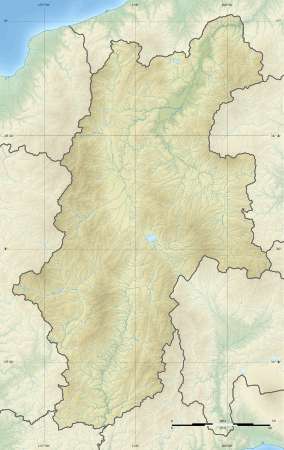Tobayama Cave
Tobayama Cave (鳥羽山洞窟, Tobayama dōkutsu) is an archaeological site consisting of a cave dwelling and cave tomb in use from the late Jōmon, through the Yayoi and early Kofun periods, located in what is now part of the city of Ueda, Nagano in the Chūbu region of Japan. The site was designated a National Historic Site of Japan in 1978.[1]
鳥羽山洞窟 | |
 Tobayama Cave  Tobayama Cave (Japan) | |
| Location | Ueda, Nagano, Japan |
|---|---|
| Region | Chūbu region |
| Coordinates | 36°17′54″N 138°15′29″E |
| Type | grave |
| History | |
| Periods | Jōmon to Kofun period |
| Site notes | |
| Ownership | National Historic Site |
| Public access | None |
Overview
The site is located on a rocky mountain approximately 15 meters from the Chikuma River, with an entrance height of 25 meters and a depth of only 15 meters. Excavation surveys have found that the cave was inhabited for several centuries, with relics from the Jōmon and Yayoi periods found in several strata of debris. In the Kofun period (approximately 5th century AD), the floor of the cave was paved with stones, and it was used as a tomb, presumably by local clans who did not build kofun tumuli. Human remains were found in three strata from this period, including one strata were multiple remains were all of crushed bones. Grave goods included numerous iron weapons, horse fittings, whetstones, copper bracelets and Sue ware pottery.
Some of the artifacts uncovered are on display at the Ueda Municipal Maruko Museum.
References
- "鳥羽山洞窟" (in Japanese). Agency for Cultural Affairs.
External links
- Ueda city official site (in Japanese)
- Ueda Municipal Maruko Museum site {ja}}